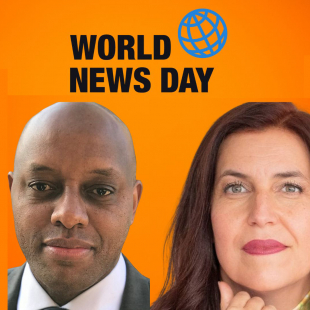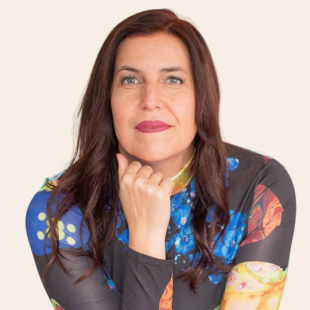The Missing Perspectives of Women in COVID-19 news TEDx talk

Luba Kassova, Co-Founder and Director, AKAS, authored the two Missing Perspectives in News reports IN 2020 which were commissioned by the Bill & Melinda Gates Foundation. In November 2020 she was invited by TEDxJohannesburg in partnership with TED and Skoll Foundation to record a TED talk sharing the key findings in her reports. Here is a transcript of her talk.
Imagine that you have woken up in a world where the volume of women’s voices has been turned down to 2, whilst the volume of men’s voices has been turned up to 10. A world where women’s voices are hardly heard by the police, or politicians or the news media. This was the world many generation-X(ers) grew up in where I come from. In that world, I was advised to try to be less vocal than men, and to give way to men’s opinions. I saw my mother and many of my friends’ mothers stand in the shadows of their husbands’ professional accomplishments. And I did not question this status quo. Not until a few years ago, after numerous conversations, I decided that these values that put men at the centre of society in its public dimensions, which we call patriarchal values, were outdated in the UK, where I now live. I waved goodbye to the past and moved forward optimistically into what I believed was the new world of gender equality.
It is in the context of examining this world that I am here now. My name is Luba and my work passion is to help organisations to understand human beings and to put men and women alike, at the heart of their decision making rather than to rely solely on their leaders’ ‘gut feel’. It was this focus of my work that led The Bill & Melinda Gates Foundation to ask me to investigate the role of women in news media and to explore the extent to which women’s voices, as opposed to men’s, are heard.
So today, I am standing before you, having written two reports on the subject, both produced during the first wave of the COVID pandemic. They have been based on an analysis of millions of news stories by Media Ecosystems Analysis Group and of thousands of sources examined by my consultancy AKAS. And through them, I have uncovered a painful truth: that the world in the past I asked you to visualise earlier is actually the world that news media presents today. News today is still predominantly a man’s affair whether you are in the global north or the global south. It reports on a world where decisions are made mainly by men and where women’s voices are largely unheard even amid the most consequential crisis of the 21st century to date –the COVID-19 pandemic – which has hit women particularly hard across many dimensions: economic, social, political, cultural and psychological.
I am also standing before you as a mother who, like millions of others this year, bore the brunt of unpaid work during the lockdown, struggling to educate my children and to keep a household going while working intensely at the same time. I felt deeply for the women around me who were forced to give up their jobs due to a lack of suitable childcare or whose job security disappeared during lockdown. The tensions they, and we, have lived through were summarised potently in the headline of an FT article posing the question: “Is the coronavirus crisis taking women back to the 50s?”
When friends and family ask me what I have been working on, I tell them that I have been investigating to what extent women in six countries across the globe - Nigeria, Kenya, South Africa, India, the UK and the US - express their views in the news on important matters, such as how COVID impacts their lives. At this point friends typically ask me what I have found. So I invite them to imagine an a capella choir of 32 people singing an ode to economics. 31 of them are men and 1 is a woman. “Do you think that the woman’s solitary voice is being heard or being lost?” I ask. “lt’s being lost”, they say. “Indeed, it is”. This is the evidence that I have found: that women’s share of voice in the news is being largely lost. In 2019, on the news topic of the economy, men’s voices outnumbered women’s voices by a factor of up to 31. For news in general, the story was somewhat better but still depressing. For every woman who expressed her perspective in the news in 2019 there were up to 6 men drowning it out.
“So what?“, people often say. “Why does it matter whether women are in the news or not, as long as the news objectively reports reality?” Well, this is where we are forced to acknowledge a fallacy: the fallacy that an “objective reality” exists somewhere out there. Academic research on how the news has been framed in recent decades has shown that there is no such thing as an objective reality that a journalist dispassionately describes. The decisions about what to report and what constitutes the reality of a situation are intricately linked to one of many possible perspectives. What journalists choose to focus on is as important as what they choose to leave out of their story. How they define a problem, what has caused it and the solutions that could resolve it are one slice of reality among many that journalists can choose to present. And their decisions about what story to tell impact lives and livelihoods.
Let me take aspects of the COVID news story as an example of reality being, more often than not, omitted from reporting. When women are left out of COVID news coverage, whether as sources, experts or main characters in the news story, we (the public) don’t hear about their unique problems such as:
- how disempowering and scary it feels to be left out of COVID testing (which happens in some socially conservative countries);
- or how tough it is to combine childcare, and care for parents and spouses with work;
- or how devastating it is to be stuck in a confined space with a violent partner;
- or how petrifying it is to be denied an antenatal check-up because resources have been redirected away from maternal healthcare towards containing the pandemic;
- or how unfathomably painful it is not only to lose a husband to COVID-19, but also your home, because it was he who owned it.
When women-centred, all-too-frequently experienced stories such as these remain untold, it leads the politicians responsible for designing social policies in response to the pandemic to miss out from their policy making a whole raft of issues that are unique to women. And since most politicians are themselves men social policies become very male-centred, just like the news itself.
The situation triggers endless questions:
Why is it, that in the 21st century, news coverage across all the 6 countries the team researched globally is facing a universal problem: women’s voices are muted across the whole lifecycle of a news story?
- starting from the editors who make the decisions about what news to run;
- followed by the voices amplified in the news;
- and finishing with those who consume the news, including those who have the power to introduce political and social changes as a result of the news they have consumed.
Why is it that in news stories men are up to 6 times more likely than women to appear as the main characters? And even when the news coverage is about gender issues, the majority of the main characters in it are still men? It’s as if the female solo part in the choir has been given to the man with the highest pitched voice!
Why is it that of the people who were portrayed in COVID-19 news coverage as empowered (“the positive role models that young people live up to”) only 17% were women and 83% were men?
Why is it that women who are victims of crime are treated less compassionately in news coverage than men and more harshly when they are the perpetrators?
And why is it that one political story we came across focused on the appearances of women politicians, referencing their body odour and sexual behaviour in a derogatory way, but did not do the same for the men politicians who featured in the same story?
The answer to these questions is that we live in societies where patriarchal norms still dominate or linger in our collective consciousness and these are mirrored in news organisations and news coverage. Interestingly, when I put this forward as the reason behind men’s dominance in news, it often somehow falls flat. There is a silence. “Is that it?” is the latent question I hear in that silence. The truth is: people and organisations often don’t take this reason seriously enough. In countries in the global north, people frequently think that patriarchal values are a thing of the past. In the global south, people often think that gender equality has progressed far enough. In both cases, we are sleepwalking through a reality that is vastly different from what we think it is. The most heart-breaking consequence of all this is that it is exceedingly difficult to fix something which is not seen as broken. Many men and women (particularly from the global south) believe that changes that enable women’s rights have gone far enough in their country, suggesting that they see the situation as satisfactory. At the same time, astonishingly, more than half of men and women in Nigeria, approximately a third in South Africa and more than one in ten in the UK and the US believe that it is acceptable for a man to beat his wife. And, distressingly, the vast majority of men and women in South Africa, India and Nigeria and a significant minority in the UK and the US hold anti-women biases.
It seems to me that this is a situation that demands action. And there are steps we can take:
The first step to tackling women’s marginalisation in news globally lies in accepting that pro-male biases exist and acknowledging that patriarchal values are still woven into the very fabric of our societies. The second step is to feel uncomfortable about this fact.
There are three sets of solutions that address the issue of women’s under-representation in news.
- The first centres around increasing the awareness of the problem
- The second seeks to remove the barriers to women being heard in news while
- The third set of solutions is focused on nudging new habits or creating new initiatives.
A great tried and tested example of a solution aimed at raising awareness of the problem is simply asking journalists to count how many men vs. how many women feature in the news coverage that they produce. This is how the successful BBC 50:50 project started. When journalists do this, invariably, most of them are surprised to find that the proportion of women is much lower than they thought. For those who are unconvinced of the importance of this, an effective way of helping journalists to care about the gender imbalance in news coverage is to offer gender sensitivity training across the whole organisation, from the governance structure (which is typically heavily male dominated) all the way down to the journalists in newsrooms .
Another successful solution, this time aimed at removing barriers to women’s voices being heard in news, is to put together lists of women experts - not only scientists, political figures, and medical experts, but also paramedics, nurses or educators. This has been tested and shown to work well: lists make it easier for journalists to quickly find women expert sources who can feature in their reports.
Developing checklists that journalists can use when they want to bring in a woman-centred angle in a story (such as the COVID-19 pandemic) is also effective in providing a cue for developing a new habit (as is argued by behavioural scientists). These checklists could include key COVID-related topics that are relevant to women such as health and healthcare, employment, gender-based violence, childcare, and education.
***
The American writer Rebecca Solnit once said: “Who is heard and who is not defines the status quo…By redefining whose voice is valued, we redefine our society and its values.” The Nigerian writer Chimamanda Ngozi Adichie said: “Culture does not make people. People make culture.” So allow me to leave you with this appeal.
Next time you consume the news, ask yourself: “Whose perspectives are being amplified in the news?” Is there harmony and balance between men and women in the news choir? Can I hear women’s voices distinctly?” If the answer to the last two questions is “no” then choose to act. Question, post, tweet, comment, write, complain, debate.
If you are a journalist, look for women experts, main characters and sources to feature in your stories. Once you have found them, please give them a voice to bring this much-needed harmony and gender balance to the powerful global news choir.
Thank you
If you would like to follow up on the topics discussed in this article, please contact Luba Kassova or Richard Addy on contact@akas.london







